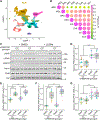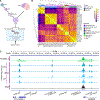Association of a common genetic variant with Parkinson's disease is mediated by microglia
- PMID: 35895835
- PMCID: PMC9809150
- DOI: 10.1126/scitranslmed.abp8869
Association of a common genetic variant with Parkinson's disease is mediated by microglia
Abstract
Studies of multiple neurodegenerative disorders have identified many genetic variants that are associated with risk of disease throughout a lifetime. For example, Parkinson's disease (PD) risk is attributed in part to both coding mutations in the leucine-rich repeat kinase 2 (LRRK2) gene and to a common noncoding variation in the 5' region of the LRRK2 locus, as identified by genome-wide association studies (GWAS). However, the mechanisms linking GWAS variants to pathogenicity are largely unknown. Here, we found that the influence of PD-associated noncoding variation on LRRK2 expression is specifically propagated through microglia and not by other cell types that express LRRK2 in the human brain. We find microglia-specific regulatory chromatin regions that modulate the LRRK2 expression in human frontal cortex and substantia nigra and confirm these results in a human-induced pluripotent stem cell-derived microglia model. We showed, using a large-scale clustered regularly interspaced short palindromic repeats interference (CRISPRi) screen, that a regulatory DNA element containing the single-nucleotide variant rs6581593 influences the LRRK2 expression in microglia. Our study demonstrates that cell type should be considered when evaluating the role of noncoding variation in disease pathogenesis and sheds light on the mechanism underlying the association of the 5' region of LRRK2 with PD risk.
Conflict of interest statement
Competing interests
Authors declare no competing interests.
Figures






References
-
- Nalls MA, Blauwendraat C, Vallerga CL, Heilbron K, Bandres-Ciga S, Chang D, Tan M, Kia DA, Noyce AJ, Xue A, Bras J, Young E, von Coelln R, Simón-Sánchez J, Schulte C, Sharma M, Krohn L, Pihlstrøm L, Siitonen A, Iwaki H, Leonard H, Faghri F, Gibbs JR, Hernandez DG, Scholz SW, Botia JA, Martinez M, Corvol J-C, Lesage S, Jankovic J, Shulman LM, Sutherland M, Tienari P, Majamaa K, Toft M, Andreassen OA, Bangale T, Brice A, Yang J, Gan-Or Z, Gasser T, Heutink P, Shulman JM, Wood NW, Hinds DA, Hardy JA, Morris HR, Gratten J, Visscher PM, Graham RR, Singleton AB, 23andMe Research Team, System Genomics of Parkinson’s Disease Consortium, International Parkinson’s Disease Genomics Consortium, Identification of novel risk loci, causal insights, and heritable risk for Parkinson’s disease: a meta-analysis of genome-wide association studies. The Lancet Neurology 18, 1091–1102 (2019). - PMC - PubMed
Publication types
MeSH terms
Substances
Grants and funding
LinkOut - more resources
Full Text Sources
Medical
Molecular Biology Databases
Research Materials

